
PREV ARTICLE
NEXT ARTICLE
FULL ISSUE
PREV FULL ISSUE
HIGHLIGHTS OF JACQUIER’S AUCTION 42
Here is the press release for an upcoming sale of ancient coins by dealer Paul-Francis Jacquier. For bibliophiles, included in the sale
are many lots of numismatic literature. -Editor
September 16, 2016 Paul-Francis Jacquier, Kehl am Rhein Auction 41 – Classical Coins and Ancient Art Auction 42 – The Michel Thys Collection “Gallic Empire“ 450 lots featuring coins of the Gallic Empire at Jacquier’s An unbelievable number of 450 lots featuring coins of the Gallic Empire are on offer at Paul- Francis Jacquier’s auction on September 16, 2016 with a focus on antoniniani and denarii, including all rarities imaginable. Postumus, Laelianus, Marius, Victorinus, Tetricus I and his son Tetricus II – these were the emperors ruling over the so called “Gallic Empire“, which, during its biggest geographical expansion wasn’t only Gaul, but also comprised Germania, Raetia, Spain and Britain. Although written records are sparse, numismatic sources are plentiful. And how plentiful the new catalog of the Paul-Francis Jacquier auction house demonstrates: It features the roughly 450 lots of the Michel Thys Collection “Coins of the Gallic Empire”; accompanied by up-to- date scholarly comments. ((Abb. 01 – The collector Michel Thys.))
The main focus of the collection are antoniniani, the main denomination of this era, as well as billon denarii, which normally were struck from the dies of gold coins. Of course there are also sestertii, even though they didn’t receive as much enthusiasm from the collector. What was fascinating to Michel Thys were the many imitations of the local mints, following the model of Roman coins. At the end of the auction numerous of these imitations will be offered at collector friendly estimates. In general, don’t let the specimens presented in the following mislead you. The auction will offer many lots in the two-digit region. Whoever is interested in coins of the Gallic Empire should not miss out on this auction! 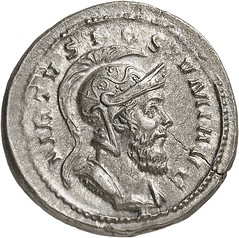 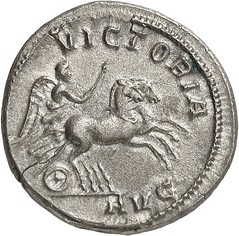
((509 – Postumus. Denarius (billon off-metal strike from an aureus die), Cologne, fall of 261. C. 399 (150 Fr.). Elmer 174 (Aureus). Schulte 11b (this coin). From the Hoffmann Collection, Rollin & Feuardent Auction (1898), 1942. Unique. Extremely fine. Estimate: 8,000 euros)) Postumus There are so many Postumus highlights, it’s hard to decide which ones to mention and which ones to skip. One to definitely mention is a denarius of the fall of 261, minted in Cologne and struck from the dies of the Schulte 11 aureus. On its reverse it shows Victoria riding a biga to the right and cracking the whip. Schulte mentions the specimen, which is now part of the Thys Collection, as 11b (estimate: 8,000 euros). 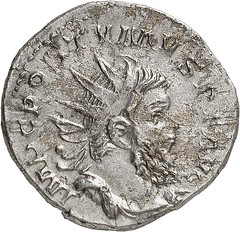 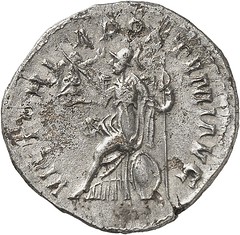
((526 – Postumus. Antoninianus, unknown mint, 263. Second known specimen. Very fine. Estimate: 4,500 euros)) Also a rarity is the extremely rare antoninianus of Postumus, displaying Victoria Postumi Augusti enthroned to the right. This is only the second known specimen (estimate: 4,500 euros). 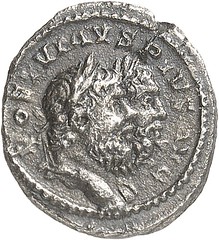 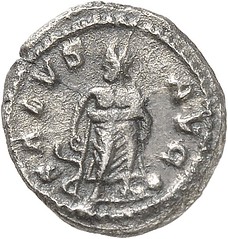
((562 – Postumus. Quinarius, Cologne, 266. C – (cf. 337). Elmer 405. Very rare. Almost extremely fine. Estimate: 3,000 euros)) Let’s not forget about the quinarius of 266, also minted in Cologne. On its obverse it displays the busts of Postumus and Hercules and on its reverse stands a facing Asclepius, a type adopted from the coins of Caracalla (estimate: 3,000 euros). 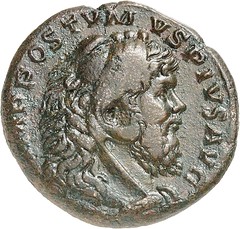 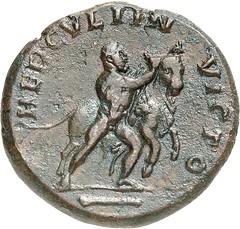
((571 – Postumus. Medallion. Bronze off-metal strike from the die of a quadruple aureus (quaternio), Cologne, end of 267 / beginning of 268. M. Thys, Un médaillon de Postume au type HERCVLI INVICTO, BCEN 29, 1 (1992), pp. 15-18. From the Kölner Münzkabinett T. Kroha 42 (1986), 530. Unique! Almost extremely fine. Estimate: 10,000 euros)) An especially spectacular piece is the medallion struck from the dies of a quadruple aureus. The obverse shows Postumus wearing a lion skin and the obverse features Hercules restraining the Cretan Bull. This is a unique specimen, which was found in the Moselle river around 1960 (estimate: 10,000 euros). 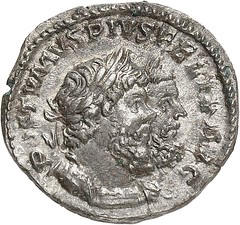 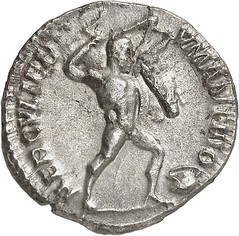
Jacquier offers a small series of denarii, which were minted in honor of Postumus’ 4th consulate using the dies of a series of aurei featuring the labours of Hercules. All show the double portrait of Postumus and Hercules on their obverses. On the reverse Hercules carries the Erymanthian Boar (estimate: 8,000 euros), Hercules cleans out the Augean Stables (estimate: 7,000 euros), and Hercules steals the apples of the Hesperides (Estimate: 7,000 euros). The series is supplemented by an antoninianus displaying the theft of the magical girdle of Amazonian queen Hippolyta (estimate: 4,000 euros). 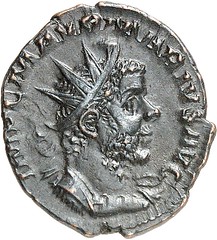 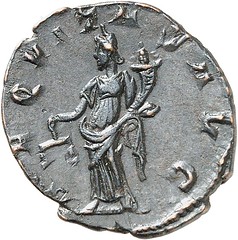
((718 – Marius. Antoninianus, Cologne. C. 2. AGK 10. Elmer 641. Extremely rare. Extremely fine. Estimate: 1,500 euros)) Marius
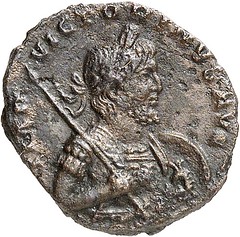 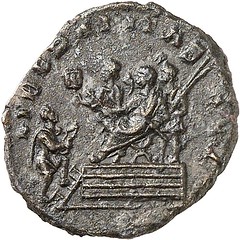
((729 – Victorinus. Denarius (bronze off-metal strike from aureus dies), Trier, ca. beginning of 270. Gilljam, Neue Abschläge der gallischen Kaiser aus einer Kölner Sammlung in: NNB 1987/3, fig. 8. Second known specimen. Almost extremely fine. Estimate: 10,000 euros)) Victorinus
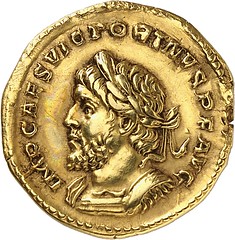 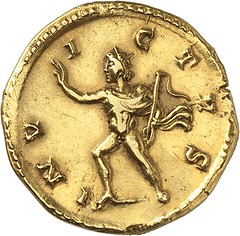
((730 – Victorinus. Aureus, Trier, beginning of 270. C. 45 (600 Fr.). Elmer 679 (this coin). Schulte 9a (this coin). Calicó 3822 (this coin). From the Récamier Collection, Bourgey Auction (1925), 458. Second known specimen. Good very fine. Estimate: 15.000 euros)) Those who have been missing aurei so far will now find a piece deriving from the Récamier Collection, which was auctioned off by Bourgey in 1925. The reverse features Sol (estimate: 15,000 euros). 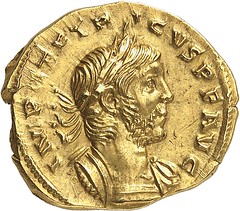 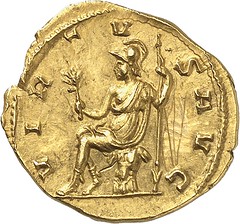
((786 – Tetricus I. Aureus, Cologne, 272. C. 202 (300 Fr.). Elmer 833 (Trier). Schulte 21a (this coin). Calicó 3916a (this coin). From the Montagu Collection, Rollin & Feuardent Auction (1896), 672 (hammer price: 920 gold francs!). Very rare. Extremely fine. Estimate: 25,000 euros)) Tetricus I and Tetricus II
Let’s close this overview with Tetricus I and his son Tetricus II. For the father, an aureus has to be mentioned. Minted in Cologne in 272, it displays Virtus on its reverse. The piece stems from the Montagu Collection and was sold for an unbelievable 920 gold francs in 1896 (estimate: 25,000 euros). 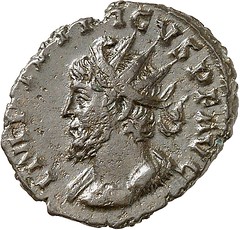 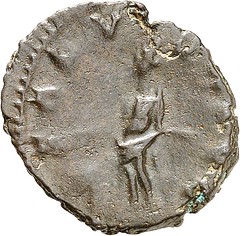
Even more rare is a left facing bust of Tetricus I, which is featured on an antoninianus of 274. Until the discovery of the Normanby Find in 1985, which, among other things, included 16,000 coins of Tetricus, an antoninianus of Tetricus displaying a left facing bust was virtually unknown. Today, only 6 specimens are known (estimate: 2,000 euros). 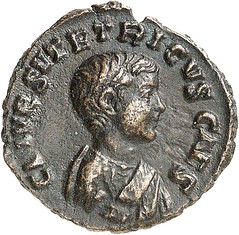 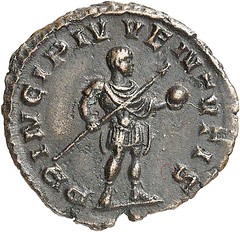
((802 – Tetricus II. Denarius (bronze off-metal strike from the aureus die), Trier, 273. Unique. Extremely fine. Estimate: 8,000 euros)) Not to be passed over is a denarius of Tetricus II, struck from the dies of an aureus showing the emperor’s son as Princeps Iuventutis. This is a unique specimen (estimate: 8,000 euros). Literature
Auction 41
Last but not least, the offerings of numismatic literature are again surely comprehensive, which is not surprising since Paul-Francis Jacquier has been specializing in it for years. The fully illustrated catalog may be ordered for 15 euros at Paul-Francis Jacquier, Honsellstr. 8, D-77694 Kehl am Rhein, Telephone: +07851 / 1217, email: office@coinsjacquier.com And to be able to bid online, please register in time at www.coinsjacquier.com. Please find the auction catalog online. Auction 42 featuring coins of the Gallic Empire you will find at Sixbid at https://www.sixbid.com/browse.html?auction=2891 Auction 41 featuring ancient coins, ancient art and numismatic literature you will find at https://www.sixbid.com/browse.html?auction=2890 
Wayne Homren, Editor The Numismatic Bibliomania Society is a non-profit organization promoting numismatic literature. See our web site at coinbooks.org. To submit items for publication in The E-Sylum, write to the Editor at this address: whomren@gmail.com To subscribe go to: https://my.binhost.com/lists/listinfo/esylum All Rights Reserved. NBS Home Page Contact the NBS webmaster 
|
